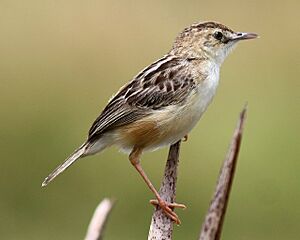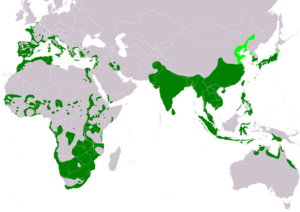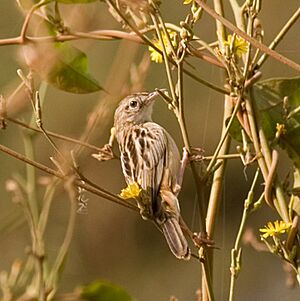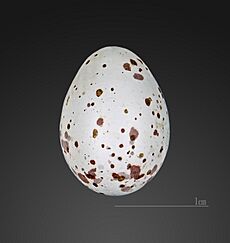Zitting cisticola facts for kids
Quick facts for kids Zitting cisticola |
|
|---|---|
 |
|
| C. j. cursitans (Batticaloa, Sri Lanka) | |
| Conservation status | |
| Scientific classification | |
| Genus: |
Cisticola
|
| Species: |
juncidis
|
 |
|
| Range of C. juncidis Breeding Resident | |
The zitting cisticola (Cisticola juncidis) is a small bird found in many parts of the world. You might also hear it called the streaked fantail warbler. It lives in southern Europe, Africa (but not deserts or rainforests), southern Asia, and northern Australia. This little bird loves grasslands.
You can often spot it by its reddish-brown lower back, called a rufous rump. It also has a brownish tail with white tips. During the breeding season, male zitting cisticolas fly in a zigzag pattern. They make a special "zitting" sound, which sounds a bit like scissors snipping! They build their nests like a pouch, hidden in clumps of grass.
About Its Name
The zitting cisticola was first described by a scientist named Constantine Samuel Rafinesque in 1810. He gave it the scientific name Sylvia juncidis. The name Cisticola comes from old Greek and Latin words. It means "rock-rose dweller." The word juncidis is from Latin and means "little reed."
There are many different types of zitting cisticolas across the world. Scientists have found about 18 different groups, called subspecies. These groups look a little different, have slightly different calls, or are different sizes. For example, the type in India, called salimalii, has a tail that stays the same length. But the type in other parts of India and Sri Lanka, cursitans, has a longer tail when it's not breeding season.
This bird used to be called the fan-tailed warbler. But its name was changed to zitting cisticola. This helps avoid confusion with another bird in America that also has "fan-tailed warbler" in its name.
What It Looks Like
The zitting cisticola is a small bird, about 10 to 12 centimeters (4 to 5 inches) long. Its back is brown with many black streaks. Its belly is whitish. The tail is wide and has white tips. The bird often flicks its tail, which is why it's sometimes called a "fan-tailed" warbler.
Male and female zitting cisticolas look quite similar. Adult males usually have fewer streaks on their heads and more markings on their backs than females. There are no big differences between the sexes. Also, there are no huge differences among the 18 different types of zitting cisticolas. You can tell it apart from a similar bird, the golden-headed cisticola, because the zitting cisticola does not have a golden band on its neck. When it's not breeding season, these birds can be hard to spot. They tend to hide deep in the grass.
Where It Lives
This bird mostly lives in grasslands. It often prefers areas near water. Most zitting cisticolas stay in the same place all year. However, some groups in East Asia fly south to warmer places during winter. In the Himalayas, they live high up in the mountains during summer. But in winter, they move to lower areas.
Sometimes, a zitting cisticola might fly far away from its usual home. It can be a rare visitor to northern Europe, especially in spring. The area where these birds live in Europe is slowly getting bigger. But cold winters can be tough for the birds living in northern areas.
Behavior and Life Cycle
Zitting cisticolas are tiny birds that eat insects. Sometimes, you can find them in small groups. They start to breed when the rainy season begins. Many areas see two groups of baby birds born each year. Male zitting cisticolas often have more than one mate. But some males only have one mate.
The male bird starts building the nest deep in the grass. He then shows off to invite females to join him. If a female likes the male, she will finish building the nest. The nest is made by weaving living leaves together with soft plant fluff, spiderwebs, and grass. It's shaped like a cup with a roof of tied leaves or grass. This helps to hide the nest.
The female lays 3 to 6 eggs. She sits on the eggs to keep them warm for about 10 days until they hatch. A pair of zitting cisticolas might raise more than one group of babies. Female birds often change mates and move to different areas. Male birds tend to stay in their own singing areas, which can change a little each day. Sometimes, female zitting cisticolas can start having their own babies when they are only one year old.




